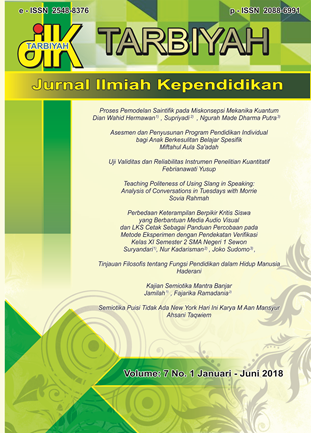Uji Validitas dan Reliabilitas Instrumen Penelitian Kuantitatif
DOI:
https://doi.org/10.18592/tarbiyah.v7i1.2100Abstract
The research instrument is a tool used to collect data or measure objects of a research variable. To obtain the correct data for the conclusion that is in accordance with the actual situation, then required a valid instrument and consistent and appropriate in providing data of research result. Instrument reliability tests to include test-retest, equivalent, and internal consistency. Internal consistency tests have several testing techniques depending on the type of instrument. Testing techniques included split half test, KR 20, KR 21, and Alfa Cronbach. The value of the validity and reliability of an instrument is influenced by the measured subject, the instrument user, and the instrument itself. Sehinggga, validity and reliability must always be tested before the instrument is used.References
Adamson, K. A. & Prion, S.. (2013). Reliability : measuring internal consistency using cronbach’s α, Clinical Simulation in Nursing, 9, hlm. 179-180.
Arikunto, Suharsimi. (2010). Prosedur penelitian : suatu pendekatan praktik. Jakarta : Rineka Cipta.
Fraenkel, J. L., Wallen, N. E., & Hyun, H. H.. (2012). How to design and evaluate research in education eighth edition. New York : Mc Graw Hill.
Streiner, D. L.. (2003). Starting at the beginning : an introduction to coefficient alpha and internal consistency, Journal of Personality Assessment, 80 (1), hlm. 99-103.
Sugiyono. (2014). Statistika untuk penelitian. Bandung : Alfabeta.
Tavakol, M. & Dennick, R.. (2011). Making sense of cronbach’s alpha, International Journal of Medical Education, 2, hlm. 53-55.
Downloads
Published
How to Cite
Issue
Section
License
Authors retain copyright and grant the journal right of first publication with the work simultaneously licensed under a Creative Commons Attribution 4.0 International License that allows others to share the work with an acknowledgment of the work's authorship and initial publication in this journal.




